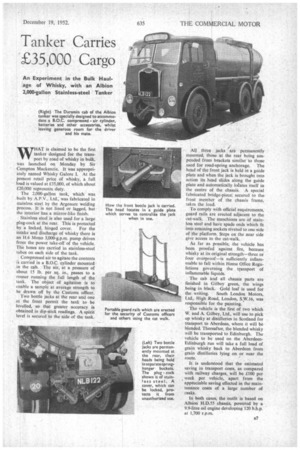Tanker Carries £35,000 Cargo
Page 41

If you've noticed an error in this article please click here to report it so we can fix it.
An Experiment in the Bulk Haulage of Whisky, with an Albion 2,000-gallon Stainless-steel Tanker
WHAT is claimed to be the first tanker designed for the transport by road of whisky in bulk, was launched on Monday by Sir Compton Mackenzie. It was appropriately named Whisky Galore I. At the present retail price of whisky, a full load is valued at £35,000, of which about £20,000 represents duty.
The 2,000-gallon tank, which was built by A.P.V., Ltd., was fabricated in stainless steel by the Argonarc welding process. It is not lined or lagged, but the interior has a mirror-like finish.
Stainless steel is also used for a large plug-cock at the rear. This is protected by a locked, hinged cover. For the intake and discharge of whisky there is an H.6 Mono 3,000-g.p.m. pump driven from the power take-off of the vehicle. The hoses are carried in stainless-steel tubes on each side of the tank.
Compressed air to agitate the contents is carried in a B.O.C. cylinder mounted in the cab. The air, at a pressure of about 15 lb. per sq. in., passes to a rouser running the full length of the tank. The object of agitation is to enable a sample at average strength to be drawn off by the Customs officer.
Two bottle jacks at the rear and one at the front permit the tank to be levelled, so that greater accuracy is obtained in dip-stick readings. A spirit level is secured to the side of the tank. All three jacks are permanently mounted, those at the rear being suspended from brackets similar to those used for road-spring anchorage. The head of the front jack is held in a guide plate and when the jack is brought into action its head slides along the guide plate and automatically lotates itself in the centre of the chassis. A special fabricated bridge-piece; secured to the front member of the chassis frame, takes the load.
To comply with official requirements, guard rails are erected adjacent to the cat-walk. The stanchions are of stainless steel and have spade ends which fit into retaining sockets riveted to one side of the platform. Steps on the near side give access to the cat-walk.
As far as possible, the vehicle has been proofed against fire, because whisky at its original strength—three or four overproof—is sufficiently inflammable to fall within Home Office Regulations governing the transport of inflammable liquids.
The cab and all chassis parts are finished in Gilbey green, the wings being in black. Gold leaf is used for
the writing. South London Motors, Ltd., High Road, London, s.yv.io, was responsible for the painting.
The vehicle is the first of two which W. and A. Gilbey, Ltd., will use to pick up whisky at distilleries in Scotland for transport to Aberdeen, where it will be blended. Thereafter, the blended whisky will be transported to Edinburgh. The vehicle to be used on the AberdeenEdinburgh run will take a full load of grain whisky back to Aberdeen from grain distilleries lying on or near the route.
It is understood that the estimated saving in transport costs, as compared with railway charges, will be £100 per week per vehicle, apart from the appreciable saving effected in the-maintenance costs of a large number of casks.
In both cases, the outfit is based on Albion H.D.55 chassis, powered by a 9.9-litre oil engine developing 120 b.h.p. at 1,700 r.p.m.




















































































